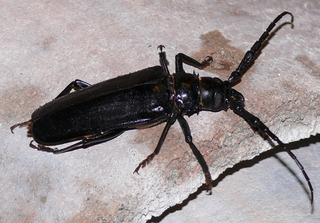
The longhorn beetles (Cerambycidae), also known as long-horned or longicorns, are a large family of beetles, with over 26,000 species described, slightly more than half from the Eastern Hemisphere. Most species are characterized by extremely long antennae, which are often as long as or longer than the beetle's body. In various members of the family, however, the antennae are quite short and such species can be difficult to distinguish from related beetle families such as the Chrysomelidae. The scientific name of this beetle family goes back to a figure from Greek mythology: after an argument with nymphs, the shepherd Cerambus was transformed into a large beetle with horns.

The Prioninae are a subfamily of Cerambycidae. They are typically large (25–70 mm) and usually brown or black. The males of a few genera sport large mandibles that are used in fights with other males, similar to stag beetles. These beetles are commonly nocturnal and are attracted to light. The majority of the Prioninae whose biology is known are borers whose larvae feed on rotting wood or roots.

Derobrachus geminatus is a species of beetle in the family Cerambycidae. For over 100 years, this species was confused with the related species Derobrachus hovorei; essentially all literature prior to 2007 therefore uses the name geminatus for the wrong species, while the true geminatus was known under the junior name Derobrachus forreri. It is an uncommon species but fairly large, reaching 70 mm in length, that can be found from southern Arizona and Texas to Sinaloa and Baja California Sur.

Stephan von Breuning was an Austrian entomologist who specialised in the study of beetles (Coleopterology), particularly within the longhorn family (Cerambycidae).

Trachyderini is a tribe of long-horned beetles in the family Cerambycidae. There are at least 140 genera and 650 described species in Trachyderini.
Derobrachus drumonti is a species of beetle in the family Cerambycidae. It was described by Santos-Silva in 2007.
Derobrachus digueti is a species of beetle in the family Cerambycidae. It was described by Lameere in 1915.

Derobrachus asperatus is a species of beetle in the family Cerambycidae. It was described by Bates in 1878.
Derobrachus brevicollis is a species of beetle in the family Cerambycidae. It was described by Jean Guillaume Audinet-Serville in 1832.
Derobrachus megacles is a species of beetle in the family Cerambycidae. It was described by Henry Walter Bates in 1884. It is found in Mexico and Guatemala.
Derobrachus granulatus is a species of beetle in the family Cerambycidae. It was described by Bates in 1884.

Derobrachus procerus is a species of beetle in the family Cerambycidae. It was described by Thomson in 1860.

Derobrachus sulcicornis is a species of beetle in the family Cerambycidae. It was described by John Lawrence LeConte in 1851.
Derobrachus hovorei is a species of beetle in the family Cerambycidae, known variously as the palo verde beetle, palo verde root borer, or palo verde borer beetle. For over 100 years, this species was confused with the related species Derobrachus geminatus, and only recognized and given its own name by Santos-Silva in 2007; essentially all literature prior to 2007 therefore incorrectly uses the name geminatus for this species. It is a longhorn beetle native to the American Southwest and northern Mexico which derives its common name from the palo verde tree, and it is one of the largest beetles in North America, reaching up to three and a half inches in length. Adults are black or brown in colour, have long antennae, and spines on the thorax. They have wings and can fly, albeit awkwardly at times. Mature beetles emerge in the summer to mate. Adults do not eat, and rely solely on their energy reserves until they die in about one month. While not harmful to humans, they can bite in self-defense.
Derobrachus lingafelteri is a species of beetle in the family Cerambycidae. It was described by Santos-Silva in 2007.
Derobrachus wappesi is a species of beetle in the family Cerambycidae. It was described by Santos-Silva in 2007.
Derobrachus thomasi is a species of beetle in the family Cerambycidae. It was described by Santos-Silva in 2007.
Derobrachus leechi is a species of beetle in the family Cerambycidae. It was described by Chemsak & Linsley in 1977.
Derobrachus inaequalis is a species of beetle in the family Cerambycidae. It was described by Henry Walter Bates in 1872.

Derobrachus longicornis is a species of beetle in the family Cerambycidae. It was described by Henry Walter Bates in 1872.








